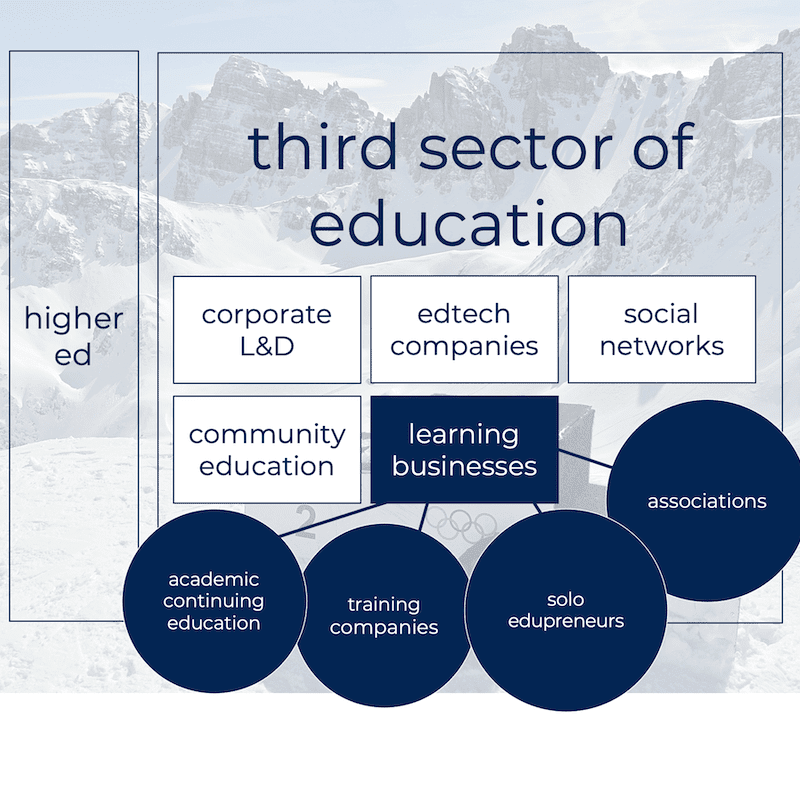As we just said goodbye to 2021 and rang in a new year, it feels only natural to pause and take a moment—or, in this case, an episode—to reflect. And, as learning business leaders, we know what a profound impact reflection can have on learning.
That’s why in this first new episode of 2022, we’re looking back at the broader learning landscape and larger trends that shaped the previous year, including how the pandemic impacted learning businesses. We reflect on what we can learn from the year that’s been and what we might carry forward to elevate our learning businesses in the year ahead—and beyond.
To tune in, listen below. To make sure you catch all future episodes, be sure to subscribe via RSS, Apple Podcasts, Spotify, Stitcher Radio, iHeartRadio, PodBean, or any podcatcher service you may use (e.g., Overcast). And, if you like the podcast, be sure to give it a tweet.
Listen to the Show
Access the Transcript
Download a PDF transcript of this episode’s audio.
Read the Show Notes
[00:23] – It’s our first episode of the new year so it seems a natural time for reflection and resolutions. Dan Pink—who we spoke with in episode 199—writes about the importance and power of timing in When: The Scientific Secrets of Perfect Timing.
You can learn more about the science-based secrets of timing in the video below, but we’ll simply say that we’re going to do what’s natural at this time of year: reflect.
We know that reflection is a powerful tool for learning—in fact, we dedicated one of our early episodes to the power of reflection in learning and leading. Now, let’s look back at 2021.
The 2021 Learning Landscape in a Word
[01:54] – A lot happened in 2021. In any given year a lot happens, but 2021 had some extras: a new president in the U.S.; an ongoing pandemic, including the rise of the Delta variant and, more recently, Omicron; widespread wildfires; and space tourism, to name just a few.
If we had to describe the 2021 learning landscape in a word, we’d sum it up as:
- Essential
Learning started to show itself as essential before 2021, but the ongoing pandemic and the changing nature of work have showed learning was extremely important, necessary, and fundamental.
Learning is so necessary and fundamental that, even given the delivery challenges caused by COVID, we collectively, as a society, tried to figure it out. How do we as learning organizations continue to provide learning? And how do we as individuals take advantage of what’s out there and continue to grow and develop ourselves?
Celisa Steele
- Unbalanced
The tremendous rush we saw to online learning beginning in 2020 tipped the balance from face-to-face to digital forms of education, which also tended to tip the balance away from the human interaction that naturally emerges in face-to-face environments. And the types of online experiences people got didn’t offer much variety.
Learning businesses are trying to come to terms with approaches like hybrid conferences and blended learning. But we’ve still got such a long way to go.
We’ve seen more organizations realize that that the different opportunities they offer for learning do not exist in neatly defined solos. This became more apparent than ever as conferences moved online, and many organizations saw themselves offering very similar content across their portfolio, usually without a lot of intentionality.
2022 is definitely going to bring a rebalancing of sorts as learning business rethink where and how they deliver different experiences and provide different types of value across their portfolios.
Jeff Cobb
Things being unbalanced almost presupposes an attempt to return to balance. The next months and years will tell us how well we do.
The Context for Learning
[06:53] – Our summations of 2021 learning speak to some of the larger trends impacting learning businesses and therefore learning. Learning always happens in context, so understanding the context is critical.
Here’s a look at that broader landscape and the larger trends that shaped 2021 and the years before as well. There are some recent-ish developments that have profoundly shaped our understanding of learning and how we can best support it.
- Neuroscience and the science of learning
Neuroscience and the science of learning have given us previously inaccessible insight into what happens to the brain as it learns. That insight has helped us identify and understand strategies for learning that are more effective (spaced repetition and effortful retrieval, for example).
To learn more about the science of learning, listen to our seven-part series, “Learning Science for Learning Businesses.”
We’ve also come to understand the importance of social and informal learning and how they’re responsible for the transference of more skills and knowledge than formal expert-led sessions. All this has profound implications for the products and services provided by learning businesses.
To learn more about social and informal learning, listen to episode 231, “The Re-Trending of Social Learning.”
[08:05] –
- Shifts in human life and work
Humans are living longer and working longer. And we are no longer likely to do the same thing over the course of our now-longer working lives. We change jobs and even careers more frequently, driven in part by technology. Automation and artificial intelligence are replacing jobs or altering responsibilities as humans use more and more technology to do their jobs.
These shifts in life and work have led to a persistent need for adaptation, a topic that we’ve discussed with Heather McGowan in episode 130 and episode 242. It’s also led to the significant growth of the third sector of education that supplements and, in some cases, replaces traditional four-year university degrees. Learning businesses help the learners they serve upskill, reskill, and generally succeed in the changing world.
In case you need a refresher, here is what we mean by “the third sector of education.”
The first sector—the preK through high school system that serves our children—and the second sector—higher education that grants degrees to the lucky among us—are well known.
The third sector of education may be less familiar, but it’s not new. The third sector serves the millions of adults who continue to learn and grow in the decades that follow their secondary and post-secondary education.
Many providers make up the third sector, including corporate learning and development, learntech companies, and just plain tech companies (we saw recently that Google is the provider of 18 of the 25 most popular new online courses in 2021).
Social networking companies like Facebook and LinkedIn are also part of the third sector, as are learning businesses, where we focus our work at Leading Learning.
Learning businesses are a key part of the third sector of education and include academic continuing education units, training companies, solo eduprenuers, and trade and professional associations. No matter the organization type, what learning businesses have in common is that they are all in a market-facing business that sells education and learning products to adults.
To learn more about the third sector of education, listen to our seven-part series, “The Surge of the Third Sector.”
Ray Schroeder—who we’re going to have on the podcast again soon (we previously spoke to him for episode 193)—explains more about Google being the provider of 18 of the top 25 new online courses in his Inside Higher Ed post, “Google Enters Higher Ed in a Big Way.”
In that article, Ray notes, “To the prospective student, our old tuition-based semester models may not compare well to $39 a month for six months to gain a credential that 150 major companies are considering the benchmark for entry-level employment.”
Ray’s focused on the higher education context, but what he’s saying applies to learning businesses as well. Certificates are a big thing in the third sector, but most that we come across have not gotten nearly the level of traction with employers that Google’s certificates have.
That’s usually because not enough rigor has been applied to understanding employer needs, and, as a result, the certificates don’t get the level of traction that they could with learners, much less with employers.
[13:02] –
- Advances in underlying technologies
The growth of mobile devices, broader Internet availability, and faster Internet through technologies like 5G mean more people have the ability to learn anytime, anywhere.
Newer modalities (virtual and augmented reality, for example, or even simply microlearning) are likely to become more prevalent as these advances in underlying technologies settle in. These advances also mean that approaches need to be rethought—learning on a smartphone is different from learning on a desktop, which is different from learning in a classroom or learning in the metaverse.
- A surge in content production
The ubiquity of technology and easy Internet access have brought about a surge in content production. In 2020, YouTube users uploaded 500 hours of video every minute. And that’s just one type of content on one platform—the same surge is happening across the Internet. The sheer volume of content exacerbates issues around discoverability and trustworthiness. How do learners quickly and easily find the most relevant, reliable content?
- The COVID-19 pandemic
The pandemic has sharpened the need for many organizations to clarify their strategy, their offerings, and their learntech needs. It has also pushed many organizations to make quick pivots. They had to react in 2020, but, in 2021, we saw the efforts of many organizations to get beyond being reactive, to be more proactive, more intentional, frankly more strategic about their learning offerings and the modes used.
Jeff Cobb
Organizations have to ask, “What stays online? What returns to in person? And, critically, why? What are the advantages of each type of delivery and relevance for particular audiences?” That reassessment and rebalancing impacted 2021 and will continue this year.
Professional Development Offerings
[15:54] – If you’re looking for ways to help your learning business thrive in 2022, we have two new options for you.
To help learning businesses, Leading Learning offers a range of complimentary educational resources, including this podcast. Leading Learning’s parent company, Tagoras, provides in-depth, customized consulting services to help learning businesses assess their markets, formulate strategy, and select appropriate technologies. We’ve provided relatively little between these two options historically. In 2022, we aim to change that with the launch of two new offerings.

- If you’re looking for a practical, concrete way to help your presenters to deliver more effective, impactful learning experiences, we have a course called “Presenting for Impact” that can help you do just that.
- If you’re looking for a structured, intentional way to make your learning businesses perform better, the Maturity Accelerator Program is designed to help organizations effectively leverage the Tagoras Learning Business Maturity Model in a way that aligns with their specific situation and needs.
If you’re interested in either or both of these professional development offerings, you can read more about the “Presenting for Impact” course and the Maturity Accelerator Program. Or you can always drop us a note at leadinglearning@tagoras.com.
The Impact of the Pandemic on Learning Businesses
[17:08] – With the context and broader trends in mind (particularly that last point around the pandemic), we’re going to turn now to some data we collected via an online survey in late October and early November 2021. We received qualifying responses from 58 organizations.
Given the profound impact of the pandemic on life, work, and learning, we asked survey respondents to let us know how COVID-19 has impacted their learning business, and we specifically asked respondents if they strongly agreed, agreed, disagreed, strongly disagreed that the pandemic had impacted their learning business about six areas specifically:
- Strategy for the learning business
- Budget for online education
- Quantity of online education
- Quality of their online education
- The kinds or formats of online education offered
- Pricing
The top three areas impacted by the pandemic per the survey were strategy, formats of online education offered, and the quantity of online education offered.
Strategy
44.4 percent of respondents strongly agreed that the pandemic has caused them to create or significantly revise their learning business strategy. We find this promising—it suggests organizations are trying to not be in purely reactive mode; they’re trying to be proactive and craft a strategy that matches this moment and will carry them into a desired future.
New Online Educational Formats
More than 40 percent of respondents strongly agreed in response to the statement “The pandemic has caused us to introduce new online educational formats.” That’s not surprising. In 2021, many organizations changed in-person conferences or seminars or courses to virtual, and some did it for the very first time, which means they added a new format to their portfolio of offerings.
Quantity of Online Education
More than 40 percent also strongly agreed that the pandemic has caused them to increase the quantity of their online educational offerings. Again, not too surprising. Given in-person education was impossible or difficult for much of the year, it makes sense that the amount of online education offered would go up.
The fewest strongly agreed that the pandemic has caused them to decrease pricing for at least some of their online educational offerings. Only 9.3 percent agreed that the pandemic has caused them to decrease pricing. Our takeaway is that organizations did a good job making it clear that any pricing breaks were temporary and in response to the current moment, and so in 2021 they were able to hold return to previous pricing levels, even if they’d cut pricing n 2020, earlier in the pandemic.
It will be interesting to see if the shift to online has a longer-term impact on the pricing of face-to-face events. Online offerings, rightly or wrongly, tend to be priced lower, and that could exert some downward pressure on face-to-face. Or we could see the opposite happen—face-to-face being positioned and priced at a premium. You could see it go either way.
With respect to pricing and otherwise, in general, it feels like 2021 was the beginning of a great experiment—and it’s far from clear at this point how it’s all going to turn out.
[21:22] – Wrap-up
Reflection Questions
As we said at the outset, now is a typical time for reflection and preparation, so we encourage you to do a year-end review for your learning business. This can be a great group exercise. Have each team member come up with their answer, then share, and discuss.
- If you had to characterize the past year for your learning business in a few words, what would you say?
And, as part of that discussion, you can elaborate on why you chose the words you did:
- What events or examples support your characterization of the year?
- What seems worth continuing into the next year, and what might need to be let go?
To make sure you don’t miss new episodes, we encourage you to subscribe via RSS, Apple Podcasts, Spotify, Stitcher Radio, iHeartRadio, PodBean, or any podcatcher service you may use (e.g., Overcast). Subscribing also helps us get some data on the podcast.
We’d also be grateful if you would take a minute to rate us on Apple Podcasts at https://www.leadinglearning.com/apple. We personally appreciate it and reviews and ratings help the podcast show up when people search for content on leading a learning business.
Finally, consider following us and sharing the good word about Leading Learning. You can find us on Twitter, Facebook, and LinkedIn.
Episodes on Related Topics:





 7 Ways to Increase Participation in Online Courses
7 Ways to Increase Participation in Online Courses
Leave a Reply